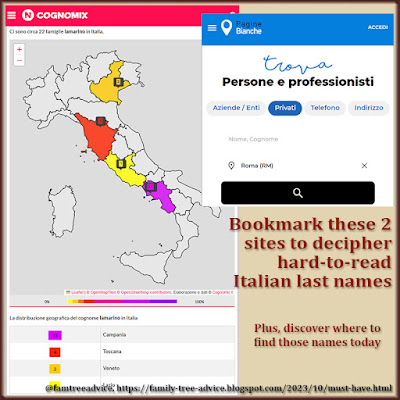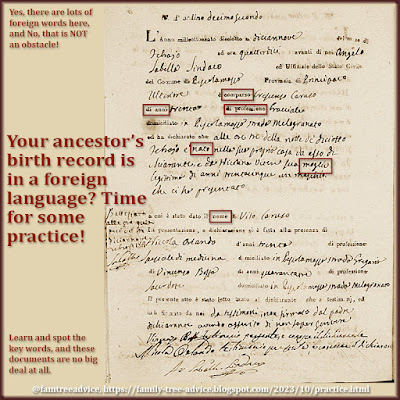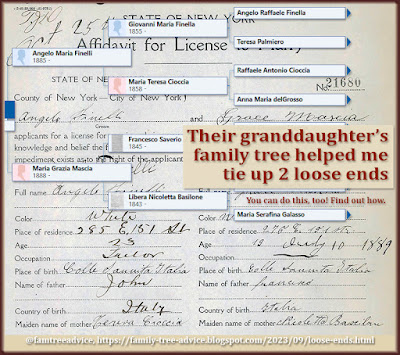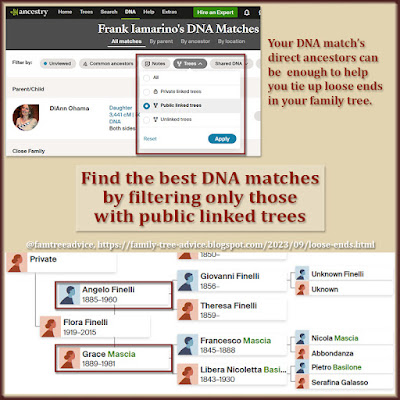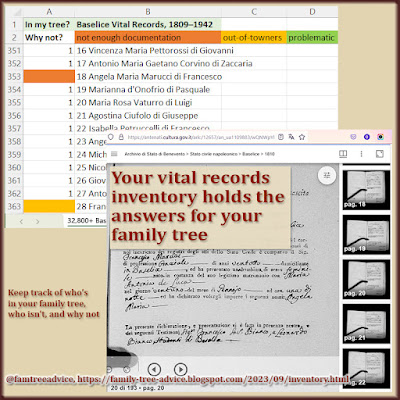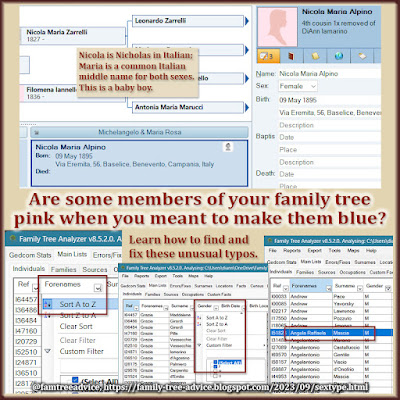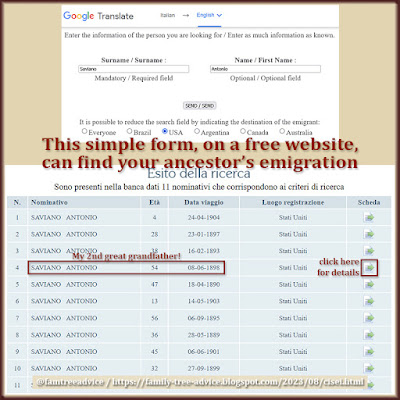I love when I'm at a family gathering and I hear one of my cousins say, "Ask DiAnn. She knows all about our family history." At a recent get-together, 2 cousins approached me separately, asking for the same basic thing.
"We need a visual," my 1st cousin said. "Give us a map that shows which ancestors were born where."
That sent my mind racing. This sounds like a great gift idea for any genealogist to make. I'd already plotted my direct ancestors on a map. The result was a highly concentrated cluster of pinpoints in a very small section of Southern Italy. My homogeneity is like having all your ancestors come from one county in America…at least as far back as the 1600s.
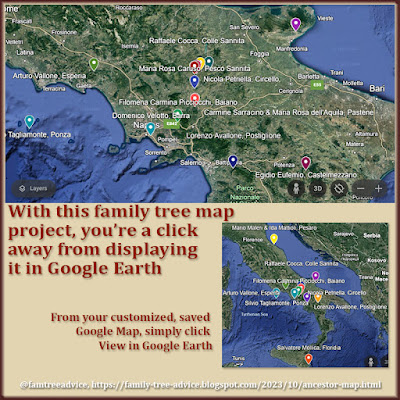 |
| It's easy to create this highly customized map to show all your cousins their ancestral roots. |
While my ancestral map is exactly the same as my brother's, it's only partly the same as any of my cousins'. However, I do know that most of the aunts, uncles, and cousins who aren't my blood relatives came from the same general area. "They stayed within their tribe," as my godmother Rae put it.
Other than one town in Sicily and another up north, I can cover all my own and my cousins' ancestors in one thin horizontal slice of Italy. It begins south of Rome and ends south of Naples.
How to Create Your Family's Ancestral Map
Part One of Two: Create a list of immigrant ancestors and their hometowns. If you've already researched the immediate families of your closest cousins, you should have all these names and places handy in your family tree. Here's how to start:
- Make a list with yourself and your siblings on line 1.
- Add a line for each set of 1st cousin siblings.
- Add a line for each set of 2nd cousin siblings.
I could include some of my 3rd cousins, but the map would get very busy.
Let me explain that the people I call "the cousins" fall into 2 main groups, both somewhat small:
- On Dad's side, I have only a brother-sister pair of 1st cousins. We've had a close relationship our whole lives. There are 2nd cousins, but since they're in Ohio, I've never known them.
- On Mom's side, we all descend from 5 Bronx-born siblings whose parents came from Italy. It's this clan that has been a constant presence throughout my life. I have three 1st cousins and 14 2nd cousins in my generation. We're compact because no one had more than 4 kids and some had only one.
For my list, I started with myself, then listed the kids of each of Mom's 1st cousins as a group. (Trust me, this is an efficient way to do it.) I added a last line for my paternal 1st cousins. Then I spelled out the immigrant ancestors' names and towns.
Here's my list of the whole family's immigrant ancestors and their hometowns. (I shrunk the text because it's a long list.)
- Me:
- Adamo Leone from Baselice
- Giovanni Sarracino and Maria Rosa Saviano from Pastene
- Pietro Iamarino from Colle Sannita
- Maria Rosa Caruso from Pesco Sannita
- Pasquale Iamarino from Colle Sannita
- S's kids:
- shared Adamo Leone from Baselice
- shared Giovanni Sarracino and Maria Rosa Saviano from Pastene
- Nicola Petriella from Circello
- Raffaele Cocca from Colle Sannita
- Nicolina Barone from Circello
- E's kids:
- shared Giovanni Sarracino and Maria Rosa Saviano from Pastene
- Arturo Vallone from Esperia
- Salvatore Mollica from Floridia in Sicily
- Domenico Velotto from Barra in Naples
- Filomena Carmina Picciocchi from Baiano
- L's kids:
- shared Giovanni Sarracino and Maria Rosa Saviano from Pastene
- shared Arturo Vallone from Esperia
- Lorenzo Avallone and Maria Cristina Romagnano from Postiglione
- A's kids:
- shared Giovanni Sarracino and Maria Rosa Saviano from Pastene
- Egidio Eufemio and Antoinette Trevignia from Castelmezzano
- R's kids:
- shared Giovanni Sarracino and Maria Rosa Saviano from Pastene
- Carmine Sarracino and Maria Rosa dell'Aquila from Pastene
- father's side from Germany and Ireland. Not in scope for this project.
- J's kids:
- shared Giovanni Sarracino and Maria Rosa Saviano from Pastene
- Matteo Rignanese and Angela Maria Frattaruolo from Monte Sant'Angelo
- B's kids:
- shared Giovanni Sarracino and Maria Rosa Saviano from Pastene
- Mario Maleri and Ida Mattioli from Pesaro
- My paternal 1st cousins:
- shared Pietro Iamarino from Colle Sannita
- shared Maria Rosa Caruso from Pesco Sannita
- shared Pasquale Iamarino from Colle Sannita
- Silvio Tagliamonte from Ponza
Whew! That's what years of research can do for you.
Part Two of Two. Begin plotting your map. You can use Google Maps for this project, but you'll probably need to have or create a free Google account to save it.
- Go to google.com/maps and clicked Saved in the left column. This should work even if you've never saved anything.
- Click Maps near the top-right, then click CREATE MAP at the bottom.
- To give your map a name, like Cousins' Roots Map, click the words Untitled Map. I also renamed the Untitled Layer to Ancestors. You could choose to create different layers for different sets of cousins.
- Consulting your list, search for an immigrant ancestor's hometown on the map.
- When you find a town, hover over its name in the left-side control panel and click the + sign that appears. This opens up a detail box. At the bottom of the box, look for and click the pencil so you can make an edit. I'm changing my saved places from just the place name to Ancestor's Name, Place Name. For instance, Pietro Iamarino, Colle Sannita. Click Save when you're done.
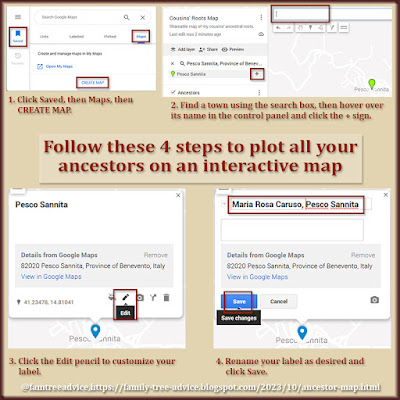 |
| Go through these 4 steps to begin creating your unique ancestral family tree map. |
Open up the Base map section at the bottom of the control panel. Try out different map styles to see which you like best. I chose the Light Landmass map to help my map pins and labels stand out. But I switched back to the first option when I needed to see street names or more detail.
Now click the words Uniform style in the control panel. Change Set labels from description to name. This puts your Ancestor Name, Place Name labels on the map.
When I clicked Uniform style again, I chose to Group place by name. Suddenly all my map pins had different colors, which is very nice.
Since I have multiple people from the same town, I couldn't see some of their names. Only the last one I entered in a town showed. To get around this problem, I chose different locations in town for my people who came from one town. I can click a different part of town for each person and add them there. It took me a couple of tries to make sure the names were far enough apart not to overlap one another. I also combined married couples from the same small town into one pin.
When you're happy with your map, click Share in the control panel. Be sure to click Anyone with this link can view. At the bottom you'll find a link you can copy and give to your cousins.
 |
| Click around to find different options to customize your ancestral family tree map. |
See what your cousins think, but you can make the map labels simpler by using the person's name only—not their town. The map itself will tell you their town. Also, if it works for you, you could use only a last name as the label.
I like that this map is interactive. You can zoom in and out and get a good idea how close or far apart your ancestors lived. My cousins want us to take a group trip to the places where our map pins are so densely clustered.
Wouldn't it be nice to print this map to a PDF file and give it to your cousins? You can! Here's how:
- Zoom in or out on the map to make all your pins visible.
- Click the 3 vertical dots to the right of your map name in the control panel and choose Print map.
- Select PDF and click Print. Play around with how much of a zoom gives you the best results.
The resulting PDF includes all the map pins you created in a list on the left, and the map on the right. If you create a separate layer for each group of cousins, you can easily print a unique gift for each set of cousins. Have fun!
Bonus! At the last second, I discovered you're a click away from exploring your map in the intensity of Google Earth. Click the 3 vertical dots to the right of your map name in the control panel and choose View in Google Earth.
